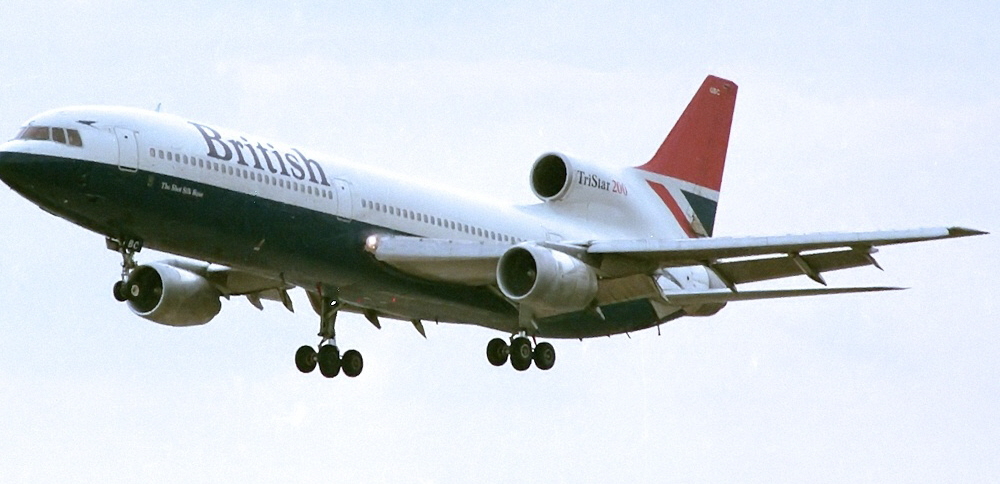 The Lockheed L-1011 TriStar, commonly referred to as the L-1011 (pronounced "L-ten-eleven") or TriStar, is a medium-to-long-range, wide-body trijet airliner. It was the third widebody airliner to enter commercial operations, after the Boeing 747 and the McDonnell Douglas DC-10. The aircraft has a seating capacity of up to 400 passengers and a range of over 4,000 nautical miles (7,410 km). Its trijet configuration places one Rolls-Royce RB211 engine under each wing, with a third, centre - mounted RB211 engine with an S-duct air inlet embedded in the tail and the upper fuselage. The main visible difference between the TriStar and its similar trijet competitor, the McDonnell Douglas DC-10, is the middle / tail engine: the DC-10's engine is mounted above the fuselage for simplicity of design and more economical construction, while the TriStar's No 2 engine is mounted to the rear fuselage and fed through an S-duct (similar to the Boeing 727) for reduced drag, improved stability, and easier replacement. The aircraft has a sophisticated autoland capability, an automated descent control system, and also available, dependant upon airline specifications, a lower deck galley and lounge facilities.
The Lockheed L-1011 TriStar, commonly referred to as the L-1011 (pronounced "L-ten-eleven") or TriStar, is a medium-to-long-range, wide-body trijet airliner. It was the third widebody airliner to enter commercial operations, after the Boeing 747 and the McDonnell Douglas DC-10. The aircraft has a seating capacity of up to 400 passengers and a range of over 4,000 nautical miles (7,410 km). Its trijet configuration places one Rolls-Royce RB211 engine under each wing, with a third, centre - mounted RB211 engine with an S-duct air inlet embedded in the tail and the upper fuselage. The main visible difference between the TriStar and its similar trijet competitor, the McDonnell Douglas DC-10, is the middle / tail engine: the DC-10's engine is mounted above the fuselage for simplicity of design and more economical construction, while the TriStar's No 2 engine is mounted to the rear fuselage and fed through an S-duct (similar to the Boeing 727) for reduced drag, improved stability, and easier replacement. The aircraft has a sophisticated autoland capability, an automated descent control system, and also available, dependant upon airline specifications, a lower deck galley and lounge facilities.
The L-1011 TriStar was produced in two fuselage lengths. The original L-1011-1 first flew in November 1970, and entered service with Eastern Air Lines in 1972. The shortened, long-range L-1011-500 first flew in 1978, and entered service with British Airways a year later. The original length TriStar was also produced as the high gross weight L-1011-100, uprated engine L-1011-200, and further upgraded L-1011-250. Post-production conversions for the L-1011-1 with increased takeoff weights included the L-1011-50 and L-1011-150.
Between 1968 and 1984, Lockheed manufactured a total of 250 TriStars, compared to 446 DC-10s, partly because of the TriStar's delayed introduction but particularly because a larger version with a longer range was not initially offered. The aircraft's sales were hampered by two years of delays due to developmental and financial problems at Rolls-Royce, the sole manufacturer of the TriStar's engines. Under state control, costs at Rolls-Royce were tightly controlled. The company's efforts largely went into the original TriStar engines, which needed considerable modifications between the L-1011's first flight and service entry. The competition, notably General Electric, were very quick to develop their CF6 engine with more thrust, which meant that a heavier "intercontinental" DC-10-30 could be more quickly brought to market. The flexibility afforded to potential customers by a long-range DC-10 put the L-1011 at a serious disadvantage. Rolls-Royce went on to develop the high-thrust RB211-524 for the L-1011-200 and -500, but this took many years. After production ended, Lockheed withdrew from the commercial aircraft business due to its below-target sales. As of 2014 there were only 17 Tristar aircraft operational in the world.

